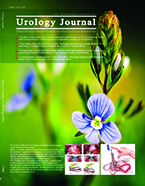Management of Nonpalpable Incidental Testicular Masses: Experience with 10 Cases
Urology Journal,
Vol. 11 No. 05 (2014),
1 November 2014
,
Page 1892-1895
https://doi.org/10.22037/uj.v11i05.2271
Abstract
Purpose: To determine the proportion of benign and malignant testicular lesions among patients with nonpalpable incidental testicular masses. Methods and Materials: Ten patients with nonpalpable incidental testicular masses underwent surgical exploration. Surgery was performed via an inguinal approach with temporary cord occlusion and frozen section examination (FSE) of the lesions. Benign findings allowed for testicular sparing surgery (TSS), whereas cancer prompted total orchiectomy. Results: The lesions measured 6-19 mm in the largest diameter. Four of the 10 lesions were benign (40%) and TSS was accomplished in these cases. Complete concordance was observed between the results of FSE and permanent histopathology examination. Of the six patients with cancer, four had pure seminoma and two were mixed germ cell tumor. Surveillance was applied in four of these patients, radiotherapy was used in one patient with seminoma and retroperitoneal lymph node dissection was done in one patient with mixed germ cell tumor. With an average follow-up duration of 24 months, all patients were alive and free of disease. All four patients in whom TSS was accomplished had an uneventful postoperative course, and after an average follow-up duration of 20 months, all had normal results in scrotal physical examination and ultrasound. Conclusion: Malignant lesion always should be considered in nonpalpable incidental testicular masses and surgical exploration is mandatory. TSS is safe and effective in patients with small benign lesions. Cancer is reliably detected by FSE.How to Cite
Ayati, M., Ariafar, A., Jamshidian, H., Soleimani, A., Ghasemi, F., & Nowroozi, M. R. (2014). Management of Nonpalpable Incidental Testicular Masses: Experience with 10 Cases. Urology Journal, 11(05), 1892–1895. https://doi.org/10.22037/uj.v11i05.2271
- Abstract Viewed: 355 times
- PDF Downloaded: 295 times
